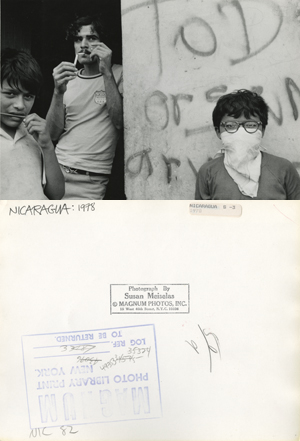
Ileana Selejan, Ph.D. candidate at the Institute of Fine Arts, New York University, recently spent time in the Magnum Photos collection with a dissertation fellowship from the Ransom Center. Selejan’s work focuses on aesthetics in war photography and protest art at the turn of the 1980s, specifically on the Sandinista revolution, the counter revolutionary war in Nicaragua.
The primary resource I consulted while in residency at the Harry Ransom Center between October and November 2011 was the Magnum Photos collection. I was interested in photographs taken in Nicaragua during the 1978–1979 Sandinista revolution and the subsequent Contra War until circa 1989, and I mainly looked at work by Susan Meiselas, Larry Towell, Abbas, and Chris Steele-Perkins. Some key questions guided my research: What constituted the “subject” for each of these photographers? How are the Sandinistas portrayed? How well documented was the counter-revolutionary side? Is there documentation of combat? How comprehensive is it? What are the main differences between work done before, during, and after the revolution? How are the victims of the war portrayed? Broader questions having to do with authorship, subjectivity, and the role of the photographer, as both outside observer and “concerned” witness, were at the core of heated debates that divided the photographic community in the 1980s. Politics and ethics, as the long war in Nicaragua proved, were hard to separate from the photographic records. The complexity of the images produced in this period is furthered with the introduction of a discussion of aesthetics.
For instance, the use of color in Susan Meiselas’s photographs from the revolution (published first in the press and later in 1981 as a group of 72 images in her seminal book Nicaragua, June 1978–July 1979) was one of the most innovative aspects of the period. Yet throughout the eighties, other Magnum photographers working in Nicaragua—Abbas, Larry Towell, and Chris Steele-Perkins—chose to stay with the rather traditional war photography aesthetic, established by earlier generations of war photographers, from Robert Capa to Henri Cartier Bresson. This style was certainly not exclusively a Magnum feature, since the majority of the photographers working in Nicaragua, local and international correspondents alike, chose black and white over color.
For at least a few years, Nicaragua became a powerful, highly controversial subject in U.S. politics and media. It cast a looming shadow over the Reagan administration throughout most of its years in power. Especially as the war in El Salvador escalated in parallel to the war in Nicaragua, many human rights workers, volunteers, journalists, and writers became involved in one way or another with the repercussions of the wars in the whole region. The violence was documented in detail, both in images and in writing. Even so, a large part of these conflicts remained unseen, forgotten, or remembered by only few of the survivors. At the same time, the contributions of numerous photographers expanded beyond the mere photographic documentation of the war. For instance, in 1990, Larry Towell published Somozas’ Last Stand, Testimonies from Nicaragua—an undersized book that consists primarily of testimonies of the victims of the war, placed along a minimal selection of his own photographs.
In 1983 Susan Meiselas co-curated the exhibition Inside El Salvador: Work of Thirty Photographers, which consisted of work by the majority of the photographers active during the war in El Salvador, including her own. It was intended as a protest show, and as it traveled in the U.S. and abroad, it attempted to raise awareness yet again to the brutal consequences of the involvement of the American government in the war. The original exhibition records, prints, and text panels are stored in the archives of the Ransom Center.
The wars in Nicaragua and El Salvador remain two of the most documented conflicts of the 1980s. Both were brutal in the extreme, and the abuses of both sides, revolutionaries and counter-revolutionaries, remain largely perplexing. Perhaps the hardest challenge has been to look at images of atrocities in such great numbers. Even as a twice-removed witness, it has been a difficult task to create distance and assume the position of the historian.
